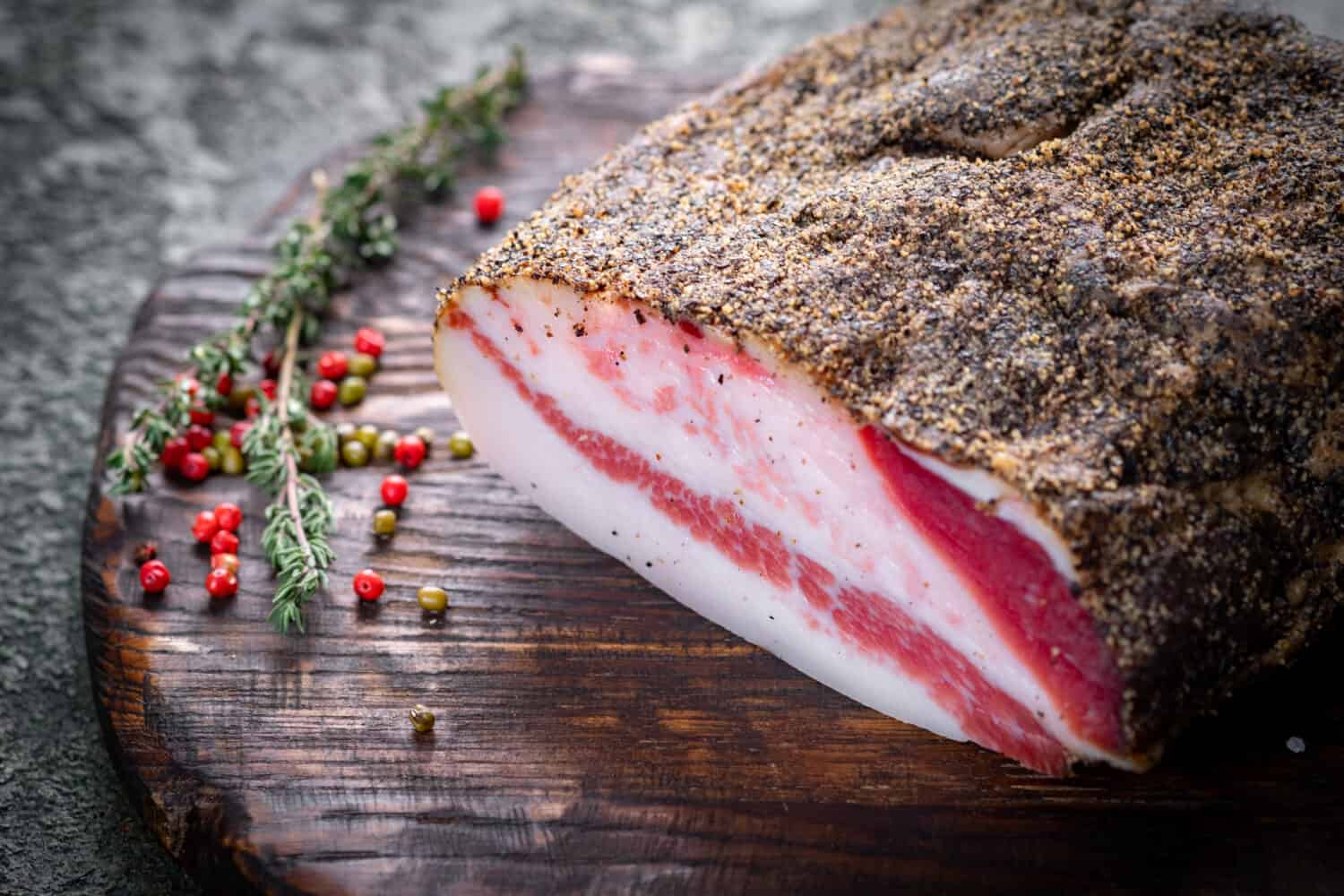Lots of meat types are made from pig: bacon, pork shoulder, ham, and more. But one of the most underrated meats that come from pigs is guanciale. It's one of the best when it comes to flavor and taste. But what is guanciale?
In short, guanciale is a word derived from the word guancia, which is Italian for the word “cheek.” Appropriately, guanciale is a meat that comes from the pig's cheeks or jowls. It's fatty, like bacon, but is often thin-sliced, which is ideal given its rich flavor. Often found on charcuterie boards or in pasta dishes, guanciale is quite versatile in terms of how it's served. Below, we will explore recipes in which guanciale works perfectly as well as where to buy this Italian cured meat, how it's made and more. Let's dig in!
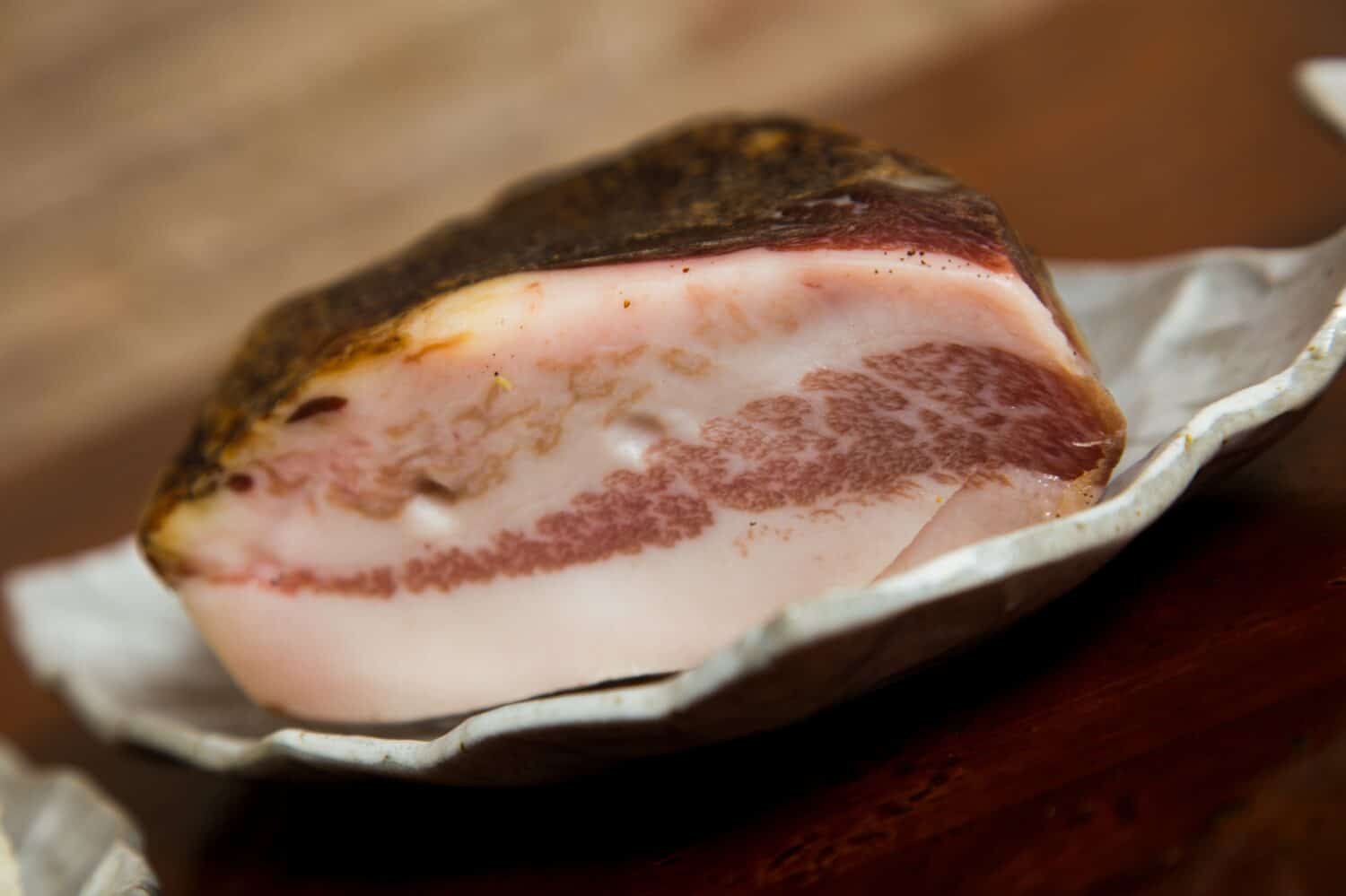
©Lecker Studio/Shutterstock.com
What Is Guanciale?
Guanciale is a fatty meat cut that comes from the cheeks or jowls of a pig. Quite salty in flavor, guanciale is most often cured before it's consumed. Similar in flavor to bacon, it is commonly used in central Italian dishes like spaghetti alla carbonara and amatriciana, which is a traditional Italian pasta sauce. While you can purchase pig cheeks raw, you'll most often find guanciale cured.
One of the ways guanciale differs from other meat is that it has a more marbled texture. There's also a good amount of fat. With a strong savory and nutty taste, guanciale has a high fat-to-meat ratio, and the flavor is often bolder than other kinds of pork.
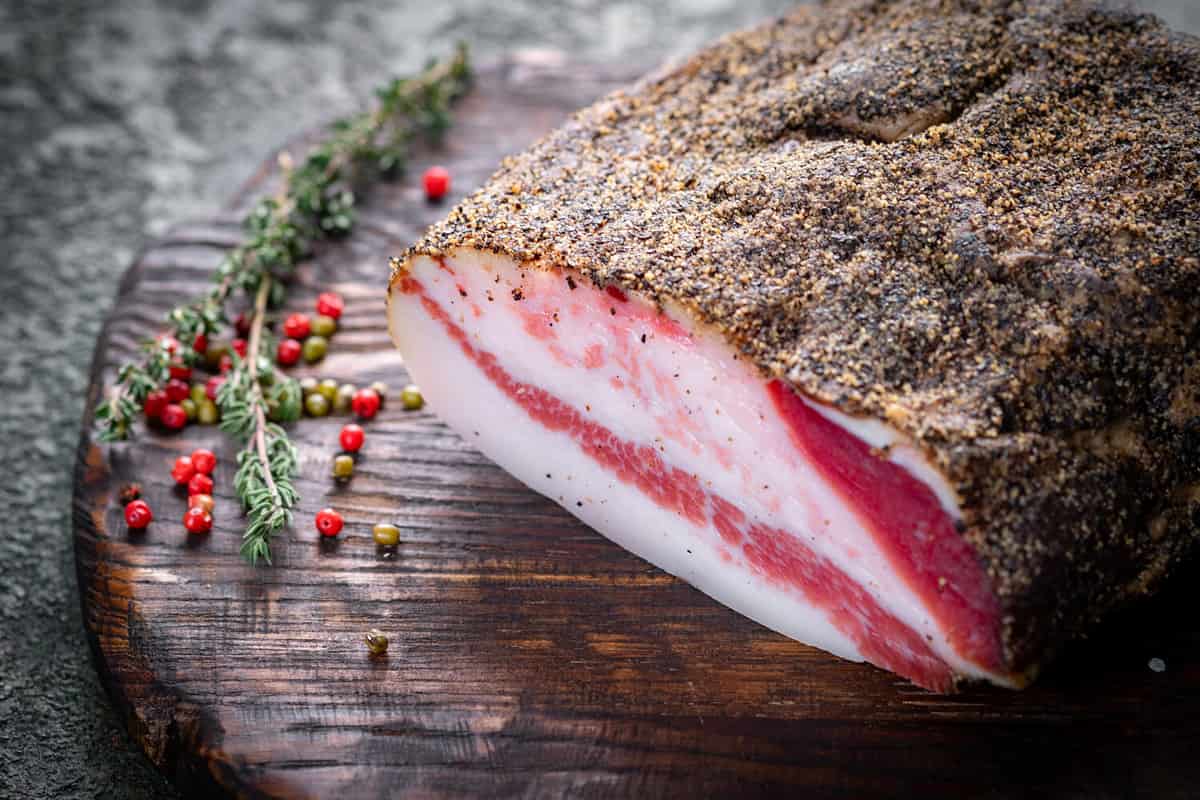
©Andrei Iakhniuk/Shutterstock.com
How is Guanciale Made?
The typical process for making guanciale is to cure it for weeks to months, depending on what kind of flavor you want. You can cure it with salt, pepper, or any other flavor. The next step is letting it air dry, which gives it even more flavor.
Where Do You Buy Guanciale?
At one time, it was difficult to find guanciale in the U.S. due to an FDA ban on the import of European meats due to the concern it could carry swine vesicular disease. That ban has since been lifted, though, and today you can get guanciale more easily at big box retailers like Walmart and Amazon. You'll find higher-quality guanciale at your local butcher or specialty grocer as well as at online fine food shops.
What Are the Best Recipes?
At its most basic, guanciale can be cooked like bacon — in a pan or in the oven at 395 degrees for 15 minutes. However, the two most popular dishes made with guanciale are spaghetti alla carbonara and amatriciana. Guanciale also often appears on charcuterie boards, atop pizza, wrapped around veggies and grilled, or simply incorporated into your standard spaghetti sauce.
Here are some recipes featuring guanciale to try for your next family dinner:
Print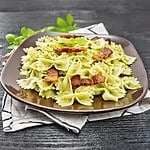
Pasta with Pesto and Guanciale
Description
Pasta with pesto and guanciale is a delicious Italian dish that combines the flavors of a classic basil pesto sauce with the rich and savory taste of guanciale, which is an Italian cured meat made from pork jowl. Here's a simple recipe to make this mouthwatering dish:
Ingredients
- 12 ounces (about 340g) of your favorite pasta (spaghetti or linguine work well)
- 1/2 cup fresh basil leaves
- 1/3 cup grated Parmesan cheese
- 1/4 cup toasted pine nuts
- 2 cloves garlic, peeled
- 1/3 cup extra-virgin olive oil
- Salt and freshly ground black pepper to taste
- 3–4 ounces (about 85-115g) of guanciale, diced
- Grated Pecorino Romano cheese for garnish (optional)
Instructions
- Start by preparing the pesto sauce. In a food processor, combine the fresh basil leaves, grated Parmesan cheese, toasted pine nuts, and peeled garlic cloves. Pulse until the ingredients are finely chopped.
- With the food processor running, slowly drizzle in the extra-virgin olive oil until the mixture forms a smooth and creamy pesto sauce. Season with salt and freshly ground black pepper to taste. Set the pesto sauce aside.
- In a large pot of boiling salted water, cook the pasta according to the package instructions until it's al dente. Remember to reserve about 1/2 cup of pasta cooking water before draining the pasta.
- While the pasta is cooking, heat a skillet over medium heat. Add the diced guanciale and sauté until it becomes crispy and golden brown. This should take about 4-5 minutes. Remove the guanciale from the skillet and drain it on paper towels to remove excess grease.
- Once the pasta is cooked and drained, return it to the pot. Add the prepared pesto sauce and toss to coat the pasta evenly. If the sauce is too thick, you can thin it out by adding some of the reserved pasta cooking water a little at a time until you achieve your desired consistency.
- Stir in the crispy guanciale pieces and toss them with the pasta and pesto.
- Serve the pasta in individual plates or bowls, garnishing with extra grated Parmesan cheese or grated Pecorino Romano, if desired.
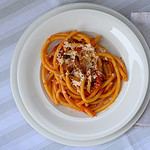
Bucatini with Tomato, Guanciale, and Chile
Description
Bucatini with Tomato, Guanciale, and Chile is a classic Italian pasta dish known for its bold flavors and satisfying combination of ingredients. Here's a recipe to make this delicious dish:
Ingredients
- 12 ounces (about 340g) bucatini pasta
- 4 ounces (about 115g) guanciale, diced
- 1 can (14 ounces) of whole peeled tomatoes or crushed tomatoes
- 2 cloves garlic, minced
- 1–2 dried red chilies (adjust to your spice preference)
- 2 tablespoons extra-virgin olive oil
- Salt and freshly ground black pepper to taste
- Grated Pecorino Romano cheese for serving (optional)
- Fresh parsley or basil leaves for garnish (optional)
Instructions
- Start by cooking the bucatini pasta in a large pot of salted boiling water according to the package instructions until it's al dente. Drain the pasta, reserving about 1/2 cup of the pasta cooking water, and set it aside.
- While the pasta is cooking, heat the olive oil in a large skillet over medium heat. Add the diced guanciale and cook it until it becomes crispy and golden brown, which should take about 5-7 minutes. Use a slotted spoon to remove the crispy guanciale from the skillet and place it on paper towels to drain excess grease. Set it aside.
- In the same skillet with the rendered guanciale fat, add the minced garlic and dried red chilies. Cook for about a minute or until the garlic becomes fragrant and just starts to turn golden. Be careful not to burn the garlic.
- Add the canned tomatoes to the skillet, breaking them up with a wooden spoon or spatula. If you're using whole peeled tomatoes, crush them as you stir. Allow the sauce to simmer for about 15-20 minutes, stirring occasionally, until it thickens and the flavors meld together.
- Season the tomato sauce with salt and freshly ground black pepper to taste. Adjust the amount of dried red chilies to achieve your desired level of spiciness.
- Add the cooked bucatini pasta to the skillet with the tomato sauce and toss to coat the pasta evenly. If the sauce is too thick, you can add some of the reserved pasta cooking water to reach your desired consistency.
- Stir in the crispy guanciale pieces and mix them with the pasta and tomato sauce.
- Serve the bucatini with tomato, guanciale, and chile in individual plates, garnishing with grated Pecorino Romano cheese and fresh parsley or basil leaves, if desired.
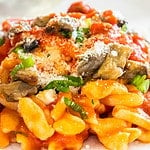
Gnocchetti all' Amatriciana
Description
Gnocchetti all'Amatriciana is a delicious Italian pasta dish featuring a flavorful sauce made with tomatoes, guanciale or pancetta, onions, and pecorino cheese. It's typically served with small pasta shapes like gnocchetti or bucatini. Here's how to make Gnocchetti all'Amatriciana:
Ingredients
- 12 ounces (about 340g) gnocchetti pasta (or any pasta of your choice)
- 4 ounces (about 115g) guanciale or pancetta, diced
- 1 small onion, finely chopped
- 1 can (14 ounces) of whole peeled tomatoes or crushed tomatoes
- 1–2 dried red chilies (adjust to your spice preference)
- 1/2 cup grated Pecorino Romano cheese
- 2 tablespoons extra-virgin olive oil
- Salt and freshly ground black pepper to taste
- Fresh parsley or basil leaves for garnish (optional)
Instructions
- Start by cooking the gnocchetti pasta in a large pot of salted boiling water according to the package instructions until it's al dente. Drain the pasta, reserving about 1/2 cup of the pasta cooking water, and set it aside.
- While the pasta is cooking, heat the olive oil in a large skillet over medium heat. Add the diced guanciale or pancetta and cook until it becomes crispy and golden brown, which should take about 5-7 minutes. Use a slotted spoon to remove the crispy meat from the skillet and place it on paper towels to drain excess grease. Set it aside.
- In the same skillet with the rendered meat fat, add the chopped onion and cook it until it becomes soft and translucent, about 3-4 minutes.
- Add the dried red chilies to the skillet with the onions. You can adjust the quantity based on your spice preference. Cook for another minute or so.
- Pour in the canned tomatoes, breaking them up with a wooden spoon or spatula. If you're using whole peeled tomatoes, crush them as you stir. Allow the sauce to simmer for about 15-20 minutes, stirring occasionally, until it thickens and the flavors meld together.
- Season the tomato sauce with salt and freshly ground black pepper to taste.
- Add the cooked gnocchetti pasta to the skillet with the tomato sauce and toss to coat the pasta evenly. If the sauce is too thick, you can add some of the reserved pasta cooking water to reach your desired consistency.
- Stir in the crispy guanciale or pancetta pieces and mix them with the pasta and tomato sauce.
- Serve Gnocchetti all'Amatriciana in individual plates, garnishing each serving with a generous sprinkle of grated Pecorino Romano cheese and fresh parsley or basil leaves, if desired.
Is Guanciale Good for You?
While bacon, guanciale, or other kinds of pork are generally not great for you, they do offer some health benefits, especially if you eat it in moderation. The biggest benefit of eating guanciale is that it contains protein, which aids muscle health. It also contains zinc, selenium, and vitamin B12. Zinc is essential for developing cells, while selenium helps reduce cancer risk. Vitamin B12 is vital to your blood and nerve system.
However, given that guanciale has high fat content, eating it in moderation is essential.
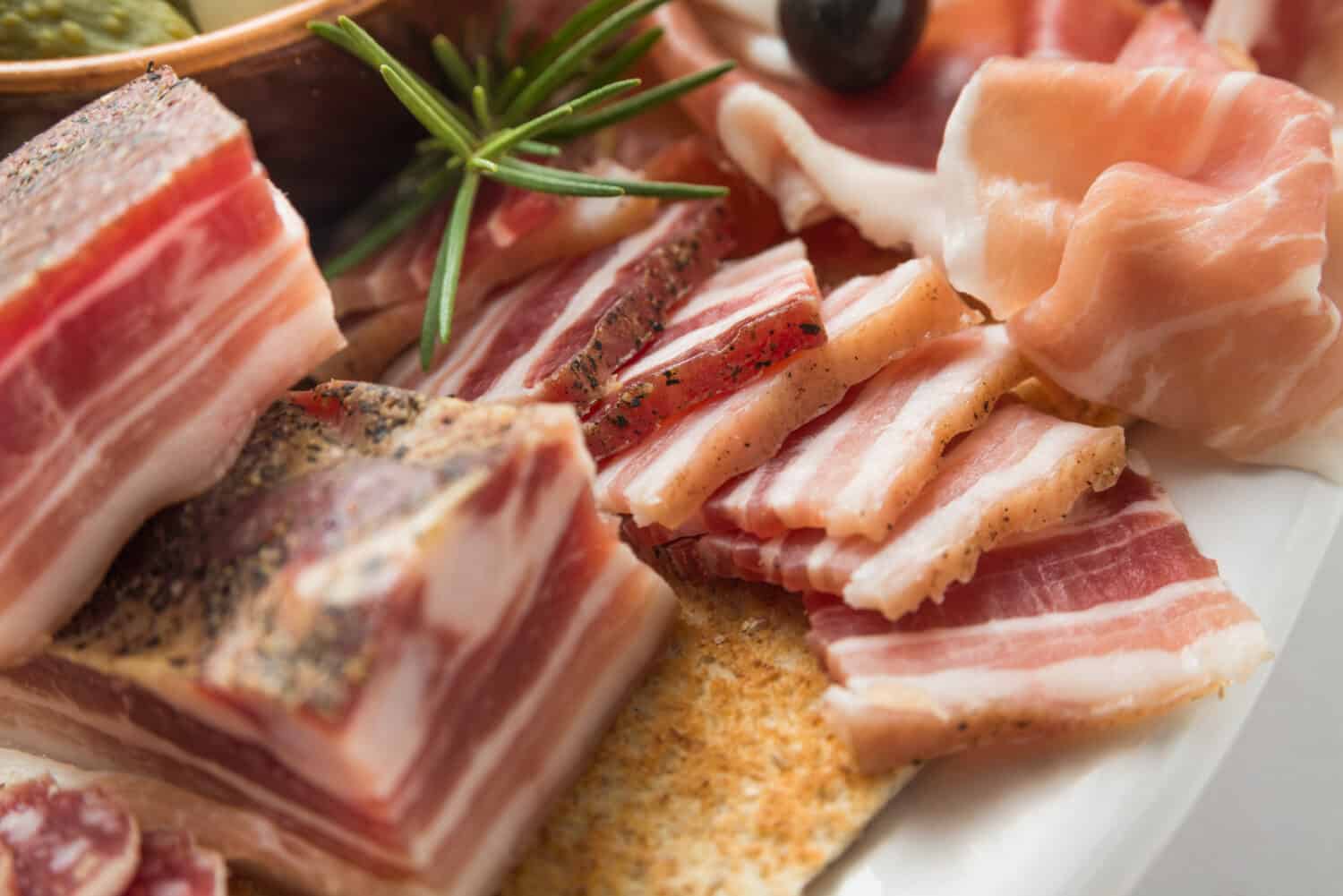
©Alessio Orru/Shutterstock.com
What Else Should You Know About Guanciale?
Guanciale is incredibly tasty. Perhaps the best thing about guanciale is that it offers variety beyond bacon or similar meat. Add it to salads, eat it with vegetables, or enjoy a hearty meal. Give it a try in your next Italian-inspired dish and you'll discover a whole new world of culinary possibilities!
The image featured at the top of this post is ©Andrei Iakhniuk/Shutterstock.com.
